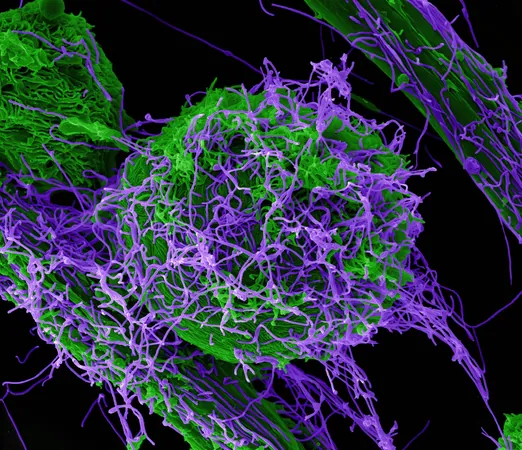
Groundbreaking Study Uncovers How Ebola Virus Escapes to the Skin Surface—What You Need to Know!
2025-01-01
Author: William
Groundbreaking Study Uncovers How Ebola Virus Escapes to the Skin Surface—What You Need to Know!
A recent study led by researchers at the University of Iowa Health Care has revealed shocking insights into the deadly Ebola virus (EBOV), known for its catastrophic outbreaks in East-Central and West Africa. Most people are aware that EBOV spreads primarily through contact with bodily fluids of an infected individual, but this groundbreaking research uncovers how the virus not only contaminates body fluids but also makes its way to the skin's surface, potentially leading to person-to-person transmission.
The alarming findings, published in *Science Advances*, demonstrate that the skin may serve as a crucial route for the virus's transmission. This new research identifies novel cell types within the skin that are infected by the Ebola virus during the late stages of infection, highlighting the skin's previously underestimated role in the spread of EBOV.
Dr. Wendy Maury, a professor of microbiology and immunology at the University of Iowa and the study's senior author, explained, “The skin is the largest organ in the human body yet has remained underexplored compared to other organs. Our findings are vital in understanding how EBOV exits the human body and provide a pathway for developing effective antiviral strategies.”
The team developed an innovative approach using human skin explants—full-thickness skin samples taken from healthy individuals—to create a model that allows them to trace the journey of the Ebola virus from the deeper dermal layers to the surface of the skin. This meticulous investigation revealed that EBOV targets various skin cell types, including macrophages and fibroblasts, but uncommonly affects keratinocytes, skin cells that had not previously been recognized as supportive of EBOV infection.
What’s more alarming is the speed at which the virus replicates; within just three days, infectious EBOV was detected on the epidermal surface. This rapid spread could have severe implications for outbreak control and emphasizes the need for heightened awareness of Ebola's transmission pathways.
The implications of this study are far-reaching. These human skin explants offer a promising model for testing antiviral therapies against Ebola, significantly enhancing our understanding of how the virus interacts with skin cells. The researchers placed particular emphasis on certain receptors on fibroblasts and keratinocytes that facilitate the virus's entry, paving the way for potential therapeutic targets.
As Ebola continues to pose a threat to public health, findings like these underscore the need for ongoing research and preventive measures to curb future outbreaks. This groundbreaking research not only redefines our understanding of EBOV transmission but also serves as a crucial step toward developing robust antiviral strategies that could save lives in regions affected by this deadly virus.
Stay tuned, as this research may hold the key to new preventive measures against one of the world's most dangerous viruses!



 Brasil (PT)
Brasil (PT)
 Canada (EN)
Canada (EN)
 Chile (ES)
Chile (ES)
 Česko (CS)
Česko (CS)
 대한민국 (KO)
대한민국 (KO)
 España (ES)
España (ES)
 France (FR)
France (FR)
 Hong Kong (EN)
Hong Kong (EN)
 Italia (IT)
Italia (IT)
 日本 (JA)
日本 (JA)
 Magyarország (HU)
Magyarország (HU)
 Norge (NO)
Norge (NO)
 Polska (PL)
Polska (PL)
 Schweiz (DE)
Schweiz (DE)
 Singapore (EN)
Singapore (EN)
 Sverige (SV)
Sverige (SV)
 Suomi (FI)
Suomi (FI)
 Türkiye (TR)
Türkiye (TR)
 الإمارات العربية المتحدة (AR)
الإمارات العربية المتحدة (AR)